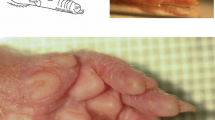Summary
The nerve endings in the epidermis of the hairless skin of the nose of the cat have been studied by means of light and electron microscopy. In the stratum germinativum there are Merkel's corpuscles. They consist of specialized cells with a thickened nerve fibre adjacent to each one of them. These receptors have been observed in two forms. Single cell-neurit-complexes are lying in the basal layer of the epidermis above the connective tissue papillae, and groups of these complexes are situated in the interpapillary pegs of the epidermis. The specialized cells are connected by desmosomes with the neighbouring cells of the epidermis. There are no free nerve endings in the hairless skin of the nose.
Zusammenfassung
Die Nervenendigungen in der Epidermis der haarlosen Haut der Katzennase wurden licht- und elektronenmikroskopisch untersucht. Im Stratum germinativum werden Merkeische Endigungen gefunden. Sie bestehen aus spezialisierten Zellen und je einer anliegenden verdickten Nervenfaser. Diese Rezeptoren werden in zwei Formen beobachtet. Einzelne Zell-Neurit-Komplexe liegen in der Basalschicht der Epidermis über den bindegewebigen Papillen und Gruppen solcher Komplexe im Stratum germinativum der Epidermalleisten (Epithelialzapfen). Die spezialisierten Zellen sind mit den umliegenden Epidermiszellen durch Desmosomen verbunden.
Freie Nervenendigungen konnten in der Epidermis der haarlosen Nasenhaut nicht beobachtet werden.
Similar content being viewed by others
Literatur
Andres, K. H.: Zur Ultrastruktur verschiedener Mechanorezeptoren von höheren Wirbeltieren. Anat. Anz.124, 551–565 (1969).
Cauna, N.: Nature and functions of the papillary ridges of the digital skin. Anat. Rec.119, 449–468 (1954).
—: Structure of digital touch corpuscles. Acta anat. (Basel)32, 1–34 (1958).
—: The mode of termination of the sensory nerves and its significance. J. comp. Neurol.113, 169–209 (1959).
—: Functional significance of the submicroscopical, histochemical and microscopical organization of the cutaneous receptor organs. Erg.-H. z. Anat. Anz.111, 181–197 (1962).
—: The effect of aging on the receptor organs of the human dermis. In: Advances in biology of skin, vol. VI, Aging, p. 63–96 (editor W. Montagna). New York: Pergamon Press 1965.
—: Fine structure of the receptor organs and its probable functional significance. In: Touch, heat and pain. Ciba Found. Symp., p. 117–127. London: I. & A. Churchill LTD 1966.
Eimer, T.: Die Schnauze des Maulwurfs als Tastwerkzeug. Arch. mikr. Anat.7, 181–191 (1871).
Fitzgerald, M. J. T.: Developmental changes in epidermal innervation. J. Anat. (Lond.)95, 495–514 (1961).
Iggo, A., Muir, A. R.: The structure and function of a slowly adapting touch corpuscle in hairy skin. J. Physiol. (Lond.)200, 763–796 (1969).
Kadanoff, D.: Beiträge zur Kenntnis der Nervenendigungen im Epithel der Säugetiere. Z. Anat. Entwickl.-Gesch.73, 431–456 (1924).
Luft, J. H.: Improvements in epoxy resin embedding methods. J. biophys. biochem. Cytol.9, 409–414 (1961).
McGavran, M. H.: „Chromaffin“ cell: electron microscopic identification in the human dermis. Science145, 275–276 (1964).
Merkel, F.: Tastzellen und Tastkörperchen bei den Haustieren und beim Menschen. Arch. mikr. Anat.11, 636–652 (1875).
Miller, M. R., Ralston III, H. J., Kasahara, M.: The pattern of cutaneous innervation of the human hand. Amer. J. Anat.102, 183–218 (1958).
— — —: The pattern of cutaneous innervation of the human hand, foot and breast. In: Advances in biology of skin, vol. I, Cutaneous innervation, p. 1–47 (editor W. Montagna). New York: Pergamon Press 1960.
Munger, B. L.: The intraepidermal innervation of the snout skin of the opossum. J. Cell Biol.26, 79–97 (1965).
—: Diskussionsbeitrag, in: Touch, heat and pain. Ciba Found. Symp., p. 129. London: I. & A. Churchill LTD 1966.
Polacek, P.: Über die strukturellen Unterschiede der Rezeptorenreihen in der Vaginalwand bei der Katze. Z. mikr.-anat. Forsch.77 (1967).
Quilliam, T. A.: Structure of receptor organs. Unit design and array patterns in receptor organs. In: Touch, heat and pain. Ciba Found. Symp., p. 86–116. London: I. & A. Churchill LTD 1966.
Quilliam, T. A.: Armstrong, J.: Mechanorezeptoren. Endeavour12, 55–60 (1963).
Reynolds, E. S.: The use of lead citrate at high pH as an electron opaque stain in electron microscopy. J. Cell Biol.17, 208–212 (1963).
Ridley, A.: Silver staining of nerve endings in human glabrous skin. J. Anat. (Lond.)104, 41–48 (1969).
Sinclair, D.: The nerve endings. In: Cutaneous sensation, p. 35–56. New York: Oxford University Press 1967.
Author information
Authors and Affiliations
Rights and permissions
About this article
Cite this article
Halata, Z. Zu den Nervenendigungen (Merkeische Endigungen) in der haarlosen Nasenhaut der Katze. Z.Zellforsch 106, 51–60 (1970). https://doi.org/10.1007/BF01027716
Received:
Issue Date:
DOI: https://doi.org/10.1007/BF01027716




